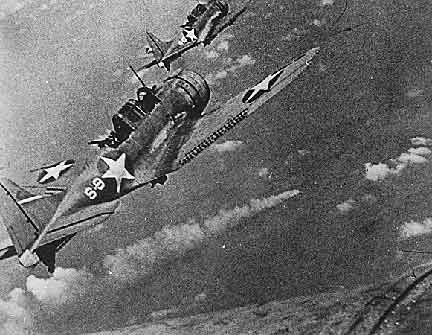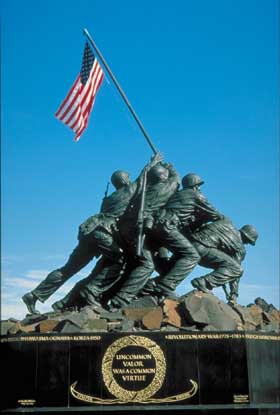 |
usa | world | animals | vocabulary | health | science | math | history |
The Pacific Theater
The Pacific Theater of Operations (PTO) is the term used in the United States for all military activity in the Pacific Ocean and the countries bordering it, in World War II. Pacific War is a more common name, around the world, for the broader conflict between the Allies and Japan, between 1937 and 1945.
Partly because of the nearly equal roles of the U.S. Army and the U.S. Navy in conducting war in the Pacific, but largely for domestic political reasons, there was not a single Allied or US commander for the theater (comparable to Eisenhower in the ETO). Indeed, the organizational structure was rather tangled, with the Joint Chiefs of Staff frequently required to be involved, and the Army and Navy commanders reporting to both the Secretary of the Navy and the Secretary of War. (No doubt the attendant difficulties helped motivate the formation of the Department of Defense in 1947.)

The two main Allied commanders in the PTO were Commander-in-Chief Pacific Ocean Areas, the title held by Admiral Chester Nimitz and Supreme Allied Commander South West Pacific Area1, General Douglas MacArthur (following termination of the short-lived ABDACOM, in early 1942.)
British, Indian, Dutch and Australian forces, already drained of personnel and matériel by two years of war with Nazi Germany, and heavily committed in the Middle East, North Africa and elsewhere, were unable to provide much more than token resistance to the battle-hardened Japanese. The Allies suffered many disastrous defeats in the first six months of the war. Two major British warships, HMS Repulse and HMS Prince of Wales were sunk by a Japanese air attack off Malaya on December 10, 1941. The government of Thailand formally allied itself with Japan on December 21. Hong Kong fell on December 25 and US bases on Guam and Wake Island were lost at around the same time.
Following the Declaration by the United Nations on January 1, 1942, the Allied governments appointed the British General Sir Archibald Wavell as supreme commander of all "American-British-Dutch-Australian" (ABDA) forces in South East Asia. This gave Wavell nominal control of a huge, but thinly-spread force, covering an area from Burma to the Dutch East Indies and the Philippines. (Other areas, including India, Australia and Hawaii remained under separate, local commands.) On January 15, Wavell moved to Bandung in Java to assume control of ABDA Command (ABDACOM).
January saw the invasions of Burma, the Dutch East Indies, New Guinea, the Solomon Islands and the capture of Manila, Kuala Lumpur and Rabaul. After being driven out of Malaya, Allied forces in Singapore surrendered to the Japanese on February 15, 1942; about 130,000 Indian, Australian and British troops became prisoners of war. The pace of conquest was rapid: Bali and Timor also fell in February. The rapid collapse of Allied resistance had left the "ABDA area" split in two. Wavell resigned from ABDACOM on February 25, handing control of the ABDA Area to local commanders and returing to the post of Commander-in-Chief, India.
At the Battle of the Java Sea, in late February and early March, the Japanese Navy inflicted a resounding defeat on the main ABDA naval force, under Admiral Karel Doorman. Allied commanders in Java surrendered.
The British under intense pressure made a fighting retreat from Rangoon to the Indo-Burmese border. This cut the Burma Road which was the western Allies' supply line to the Chinese National army commanded by Chiang Kai-shek. Filipino and US forces put up a fierce resistance in the Philippines until May 8, 1942 when more than 80,000 of them surrendered. By this time, General Douglas MacArthur, who had been appointed Supreme Allied Commander South West Pacific, had relocated his headquarters to Australia. The US Navy, under Admiral Chester Nimitz, had responsibility for the rest of the Pacific Ocean.
Meanwhile, Japanese aircraft had all but eliminated Allied air power in South-East Asia and were making attacks on northern Australia, beginning with a disproportionately large, and psychologically devastating attack on the city of Darwin on February 19, which killed at least 243 people. Japanese air power had also driven the British fleet out of Ceylon. (Air attacks on the US mainland were insignificant, comprising balloon-based materials and a submarine-based seaplane fire-bombing a forest in Oregon, September 9, 1942.)
In early 1942, the governments of smaller powers began to push for an inter-governmental Asia-Pacific war council, based in Washington D.C.. A council was established in London, with a subsidiary body in Washington. However the smaller powers continued to push for a US-based body. The Pacific War Council was formed in Washington on April 1, 1942, with a membership consisting of President Franklin D. Roosevelt, his key advisor Harry Hopkins, and representatives from Britain, China, Australia, the Netherlands, New Zealand and Canada. Representatives from India and the Philippines were later added. The council never had any direct operational control and any decisions it made were referred to the US-British Combined Chiefs of Staff, which was also in Washington.
Allied resistance, at first shambolic, gradually began to stiffen. The Doolittle Raid in April was a token but morale-boosting air attack on Japan, and although the Allied navies were narrowly defeated in tactical terms at the Battle of the Coral Sea, it still managed to derail a Japanese naval attack on Port Moresby, New Guinea. The crucial Battle of Midway followed in June: the fortunes of war could easily have given either side the victory, but Japanese naval aviation suffered a devastating defeat from which it never recovered. Midway was the turning-point of the naval war in the Pacific theatre.
Nevertheless, Japanese land forces continued to advance. A few Australian Militia (reserve) battalions, many of them of very young and untrained, fought a stubborn rearguard action in New Guinea, against a Japanese advance along the Kokoda Track, towards Port Moresby, over the rugged Owen Stanley Ranges. The Militia, worn out and severely depleted by casualties, were relieved in late August by regular troops from the Second Australian Imperial Force, returning from action in the Middle East.
In early September 1942, at Milne Bay, near the eastern tip of New Guinea, Japan suffered its first outright defeat since 1939. Japanese marines attacked a strategic Royal Australian Air Force base, defended mostly by the Australian Army, as well as some US forces. Simultaneously, US and Japanese forces were both attempting to occupy the island of Guadalcanal. Both sides poured resources into Guadalcanal over the following six months, in an escalating battle of attrition, with eventual victory going to the United States. From this time on the Japanese forces were decidedly on the defensive. The constant need to reinforce Guadalcanal weakened the Japanese effort in other theatres, leading to successful Australian-US counteroffensives in New Guinea, which culminated in the capture of the key bases of Buna and Gona in early 1943. In June, the Allies launched Operation Cartwheel, which initiated a strategy of isolating the major Japanese forward base, at Rabaul, and concentrated on cutting its lines of communication. This prepared the way for Nimitz's island-hopping campaign towards Japan.
In late 1942 and during 1943, British, Indian and African colonial forces were counter-attacking in Burma, albeit with limited success. In August 1943 the western Allies formed a new South East Asian Command to take over stratigic responsibilities for the theatre from general Wavell the Commander-in-Chief, India. The reorganisation of the theatre command took about two months and in October 1943 Winston Churchill appointed Admiral Lord Louis Mountbatten as Supreme Allied Commander of the South East Asia Command (SEAC). Working closely with General William Slim Mountbatten directed the liberation of Burma and Singapore in the Burma Campaign. General Stilwell in the CBI under SEAC, supplied aid to the Chinese forces of Chiang Kai-shek and helped to co-ordinate the Chinese attacks on the Japanese which supported the British Fourteenth Army in Burma.
On November 22, 1943 U.S. President Franklin D. Roosevelt, British Prime Minister Winston Churchill, and ROC leader Chiang Kai-Shek met in Cairo, Egypt, to discuss ways to defeat Japan.

Hard-fought battles at Tarawa, Iwo Jima, Okinawa, and others resulted in horrific casualties on both sides, but finally produced a Japanese retreat. Faced with the loss of most of their experienced pilots, the Japanese resorted to kamikaze tactics in an attempt to slow the US advance.
Towards the end of the war as the role of strategic bombing became more important, a new command for the U.S. Strategic Air Forces in the Pacific was created to oversee all US strategic bombing in the hemisphere, under USAAF General Carl Spaatz. Japanese cities suffered greatly from air attacks by US bombers. On March 9-10 1945 alone, about 100,000 people were killed in a fire storm caused by an attack on Tokyo.
On February 3, 1945, Japan's long-time enemy the Soviet Union agreed in principle to enter the Pacific conflict. Its declaration of war did not occur until August 8, which was 3 months to the day from the end of the war in Europe so fulfilling the USSR's obligation to the other Allies. In a devastating blow to Japanese morale, the US attacked two cities with nuclear weapons; these were a well-kept secret until August 6, when Hiroshima was destroyed with a single atomic bomb, as was Nagasaki on August 9. More than 200,000 people died as a direct result of these two bombings.
On August 9 the Soviet Union entered the war with Japan by launching Operation August Storm. A battle-hardened, one million-strong Soviet force, transferred from Europe attacked Japanese forces in Manchuria and quickly defeated their Kwantung Army (Guandong Army). The Soviet attack worried Emperor Hirohito, who pleaded with the war council to reconsider surrender.
In Japan, August 14 is considered to be the day that the Pacific War ended. However, Imperial Japan actually surrendered on August 15 and this day became known in the English-speaking countries as "V-J Day" (Victory in Japan). The order to surrender was not immediately sent to Japanese forces in Manchuria, who continued to fight the Soviets until August 19. Small-scale combat continued to occur throughout the Pacific, in some cases for many years. The formal Instrument of Surrender was signed on September 2, 1945, on the battleship USS Missouri in Tokyo Bay. The surrender was accepted by General Douglas MacArthur as Supreme Allied Commander, with representatives of each Allied nation, from a Japanese delegation led by Mamoru Shigemitsu.
Following this period, MacArthur established bases in Japan to oversee the postwar development of the country. This period in Japanese history is known as the occupation. U.S. President Harry Truman officially proclaimed an end of hostilities on December 31, 1946.
This article is licensed under the GNU Free Documentation License. It uses material from the Wikipedia article "World War II ".